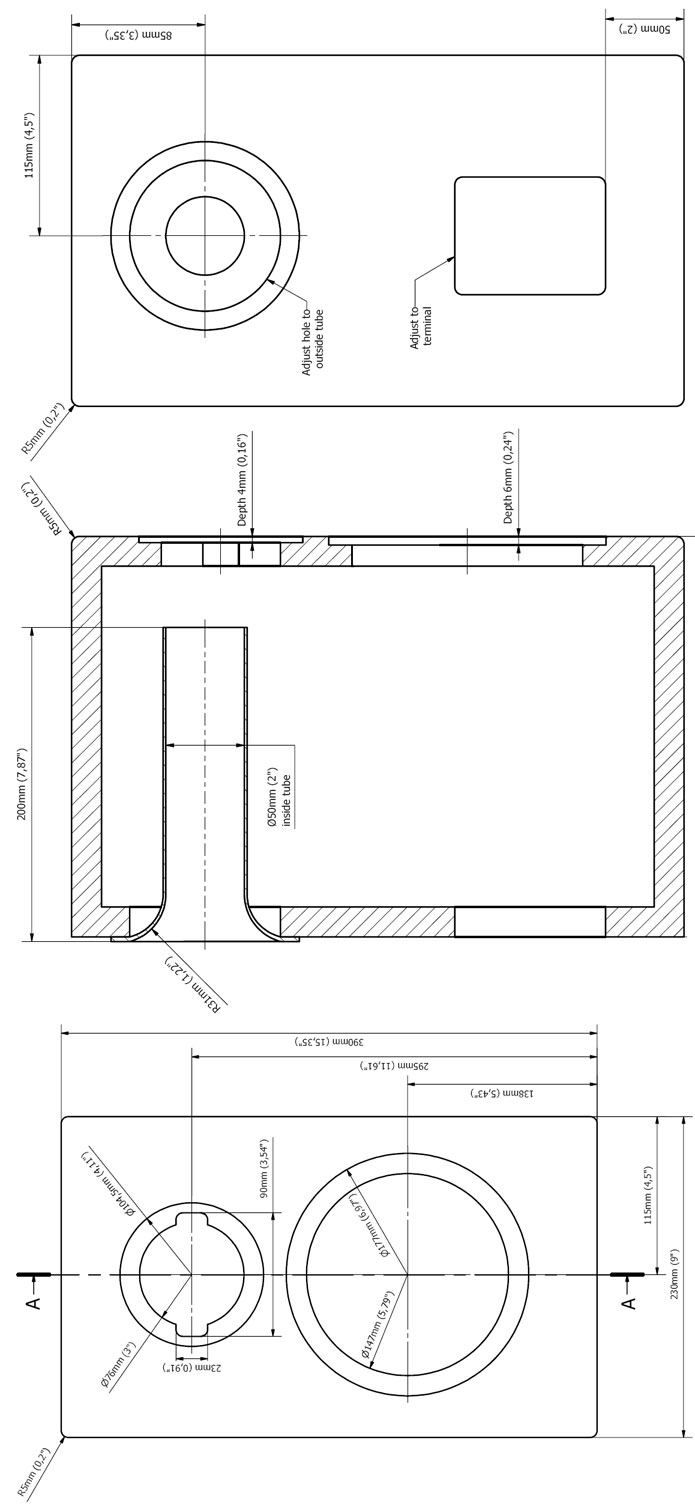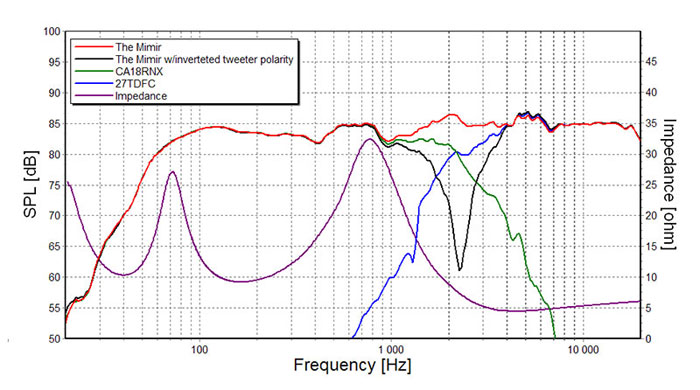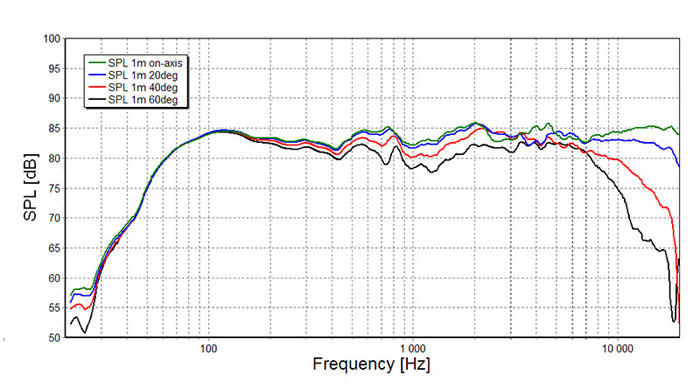
傲士音响与创立于1948年的、有着60年悠久历史的世界顶级喇叭制造商挪威SEAS首次面向发烧友联合推出的普及版发烧音箱套件mimir(巨人),由SEAS专业工程师负责设计,平价靓声、性价比极高。
 套件包括:
套件包括:
SEAS H1189 1”高音喇叭 2只
SEAS H1215 6.5”低音喇叭 2只
SEAS原厂设计重料分音器 2个
CMC原厂高级喇叭输出端子 4支
优质专用箱内线若干;安装用螺丝一套。
SEAS认可的SEAS精美铭牌 2片
套件中文说明书(根据西雅士套件原英文翻译)
原厂设计的分频器图纸
![]() 点击下载
点击下载

原厂设计的音箱图纸
![]() 点击下载
点击下载

我们最新研制的两分频喇叭套件,命名为Mimir(巨人),巨人(Mimir)是古代北欧神话中一位以知识和智慧而著名的神。这款套件是由18cm口径的纸盆涂胶低音喇叭CA18RNX和27mm直径的丝膜涂胶高音喇叭27TDFC组成。
箱体和填充材料
Mimir(巨人)音箱箱体的设计等效容积为14公升,它可在一些音箱DIY专门店自行组装完成。这款套件组装容易,适合初学者入门。如果你不想自己组装,可以找当地的套件经销商来帮你完成组装。在你组装时请记住重要的一点:保持障板宽度和正确的箱体等效容积。为了使音箱的寿命更长,建议在组装音箱时增加一些内部支撑物使箱体的强度更好。
填充物的数量和倒相管的调整是以实际测量和听音为基础进行的。音箱内用100g的吸音棉填满。吸音棉要均匀分布在音箱里,但要离开倒相孔口以便空气的自由流动,确保气流噪声尽可能低。倒相管的总长度是20cm内径是5cm。调整后的低频下限为42Hz,能提供一个平滑的低频滚降。
喇叭单元
系统中使用的是低音喇叭是SEAS CA18RNX。这是一款18cm口径的、采用传统纸盆涂胶技术的锥盆低音喇叭,这种设计为这款喇叭提供了一个有可控滚降的平坦扩展的频率响应。大型的磁体系统实现更好的瞬变,缓冲背板(弹波)与很长且很轻的铜镀铝音圈一起可以在轻度失真的情况下减少音圈位移。坚固的铸造合金盆架保证了重要部件的组合。合金盆架上较大的镂空设计使回声、气流噪声和空腔谐振等降低到最低水平。
高音喇叭使用的是SEAS 27TDFC。这是一款27mm直径的半球顶丝质涂胶振膜的高音喇叭,这个半球顶丝质涂胶振膜让这款高音喇叭实现了平坦的特性和良好的稳定性,同时也减少了空气湿度给振膜带来的影响。音圈镶嵌在一个铝制骨架上,这个铝制音圈骨架有足够的通气孔以消除内部空气流动引起的噪音。音圈在低粘度磁液中运动,以得到大功率处理能力和简化分频器设计。坚固且具有最佳听觉衰减的后腔允许27TDFC用于中等偏低分频频率。基座是玻璃钢精铸的,面板的设计提供了最佳的声音辐射条件。关于各喇叭单元的详细技术参数见数据表。
分频器
这个分频器是根据IJData的LspCAD设计的,目的就是在取得一个简单的设计的同时又能保证整体品质的稳定。喇叭的频率响应和阻抗特性是在消声室里实际测试得出的,在距离音箱高音喇叭轴线1米的点、成15度角测量的。此参考点是用于在设计中尽量减少障板边缘衍射的影响。通过测量喇叭的同一点,模拟出喇叭之间的相位响应之和。此分频器是根据经验设计的,并不局限于传统理论的公式。
高音喇叭和低音喇叭应该与分频点同步,当高音喇叭和低音喇叭相对于带通水平都是在-6dB时分频点的总和应该是平坦的。由于高音喇叭和低音喇叭有不同的灵敏度,为了达到统一的目的,就需要一个起衰减作用的2阶高通滤波器。低通部分是由一个2阶高通滤波器和一个同步补偿电路实现的,由此可提供平稳的频率响应。该同步补偿电路是由一个电感和一个电阻并联后再与喇叭串联组成的。

测量结果
频响曲线特性在距离音箱高音喇叭单元轴线1米的点、成15度角,电压2.83V。
阻抗特性:电压2V 。

从图表中看到平均灵敏度是84 dB,响应在± 2dB之内。图里的黑色曲线显示了极性反向相连的高音喇叭响应。在这个曲线图中,我们在分频点周围寻找一个深而对称的凹口,这个凹口表明喇叭在分频区域是同相的。这里,凹口有25dB以上深,证实了此系统拥有一良好的相位响应。蓝色和绿色曲线分别地显示了低音喇叭和高音喇叭的频率响应。
2阶分频结合喇叭的自然滚降提供了4阶林克维茨-莱利斜坡。分频点是2.2KHz,足够让高音喇叭在其工作范围内正常工作。同时低音喇叭的再生频率范围也不会超出设计值,从而提供平滑的频率响应。Mimir(巨人)的离轴响应显示如下。

这幅图表明,频率响应是非常平滑地贯穿整个频率范围和高音喇叭的受控离轴滚降。
下图表明2阶和3阶谐波在1m处有96dB的输出失真 。整体的失真非常低并且没有任何显著的峰值。这使得用这款套件组装的音箱播放的音乐非常干净且没有音染。

更多资料请查阅http://www.seas.no/
![]() Download Mimir plans
Download Mimir plans
Named after Mimir , a primal god of Norse mythology who was renowned for his knowledge and wisdom, we present
a new high-end two-way speaker kit.The Mimir consist of an 18 cm long throw woofer with a coated paper cone - CA18RNX , and a 27 mm coated fabric tweeter - 27TDFC .
Enclosure and stuffing
The Mimir loudspeaker is based on a standard 14 litre vented cabinet that is available assembled and finsihed at some DIY loudspeaker shops. This cabinet was chosen to give people an easy start to building a loudspeaker. Ask your local loudspeaker dealer if he can help you obtain this, if your not thinking of building it yourself. The important thing to remember when you are building this, is to keep the baffle width and internal volume of the original enclosure. Adding braces to stiffen the cabinet is a good tip for the advanced builder to take the loudspeaker just a little bit further.
The amount of stufing and port tuning is based on measurements and extensive listening. The cabinet is filled with 100 g of Acousto-Q. The stuffing is distributed evenly in the box, but kept away from the port opening to allow free movement of air. This to ensure that the airflow noise stays as low as possible. The port length is 20 cm including the flanged end and the inner diameter is 5 cm. This gives a port tuning of 42Hz providing a smooth low frequency roll-off.
Drive units
The woofer used in this system is the SEAS CA18RNX . This is a long throw 18 cm woofer with a coated paper cone. The classical coated paper cone gives a smooth extended frequency response with a controlled roll off. The large magnet system gives good transient response, and the bumped back plate together with the very long, and light weight copper clad aluminum voice coil allow for extreme coil excursion with low distortion. The extremely stiff and stable injection moulded metal basket, keeps the critical components in perfect alignment. Large windows in the basket both above and below the spider reduce sound reflection, air flow noise and cavity resonance to a minimum.
The tweeter is the SEAS 27TDFC . This is a 27 mm High Definition precoated fabric dome tweeter with a wide, soft polymer surround. The dome and surround materials give high consistency and excellent stability against variations in air humidity. The voice coil is wound on an aluminum voice coil former with adequate ventilating holes to eliminate noise from internal air flow. The voice coil is immersed in low viscosity magnetic fuid, for high power handling capacity and simplifed crossover design. A stiff and stable rear chamber with optimal acoustic damping allows 27TDFC to be used with moderately low crossover frequencies. The chassis is precision moulded from glass fibre reinforced plastic, and its front design offers optimum radiation conditions. For detailed technical parameters on the drive units see the data sheets.
Crossover
The crossover is designed in LspCAD from IJData, with the objective to obtain a simple design without sacrifcing the overall quality. Driver response and impedance were measured with the drivers mounted in the box at 1 metre distance 15 degrees off the tweeter axis in an anechoic room. This reference point was used in the design to minimize the influence of baffle edge diffraction. By measuring the drivers at the same point it is easy to simulate the summation of and phase response between the drivers. The crossover was developed empirically, without confinement to the traditional textbook filter formulas.
The drivers should be in phase at the crossover frequency, and the sum should be flat when both drivers are at -6dB relative to the pass band level. Now the inevitable vertical off-axis cancellation, which is always present with the use of non-coincident drivers, is at least outside the listening axis (tweeter axis). To accomplish the design goals it was necessary to use a 2nd order electrical filter for the high pass section, with an “l-pad” for attenuation because of the different sensitivities of the drivers. The low pass section was realised with a 2nd order electrical filter and a baffe-step compensator consisting of a parallel connection of an inductor and a resistor in series with the driver, thus providing a flat frequency response. The crossover schematics is shown in figure 2.

Measurements
Anechoic free field response at 1 meter, 15 degrees off tweeter axis, measured at 2.83V.
Impedance measured at 2V.

As seen in the figure the average sensitivity is 84dB and the response lies within ± 2dB. The black curve shows the response with the tweeter connected with opposite polarity. In this curve we look for a deep and symmetrical notch around the crossover frequency, which indicates that the drivers are in phase in the crossover region. Here the notch is more than 25dB deep, and that confirms that this system has a very good phase response. The blue and green curves show respectively the response of the woofer and the tweeter.
The 2nd order electrical crossover combinedwith the natural roll-off of the drivers gives a 4th order acoustical Linkwitz-Riley slope. The crossover frequency is 2.2 kHz, high enough for the tweeter to operate inside its limits, even at high amplitudes, and low enough so that the woofer doesn’t become too directional, and thus providing a smooth power respons. The off-axis respons of the Mimir is shown below.

This figure shows that the power response is very smooth throughout the whole frequency range, and the controlled off-axis roll off of the tweeter.
The next figure shows the 2nd and 3rd order harmonic distortion with an output of 96dB at 1m. The overall distortion is very low and without any peaks that might become noticeable. This makes the reproduced music very clean and without coloration.

欢迎致电:+86 20 3439 0041 提出您的问题,我们将竭诚为您提供服务,感谢您对傲士音响的支持与配合!